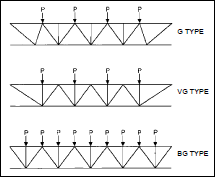Joist girders are primary framing members.
General description
A joist girder is a simple span, supporting equally spaced concentrated loads from open-web steel joists. These concentrated loads are considered to act at the panel points of the joist girder.
Joist girders are designed to allow for the efficient use of steel in longer spans. Various weight tables developed by the manufacturers (for example, Vulcraft) list joist girders from 20 inches to 96 inches deep and spans up to 100 feet. The standard configuration of a joist girder is parallel chords with underslung ends and bottom chord extensions.
Joist girders types
There are three main types of point load distribution for joist girders: G, VG, and BG, as shown in the following figure. 

According to the Steel Joist Institute (SJI) requirements, the standard designation consists of four parts as shown in the following example:




Example of a standard designation where:
- 48 corresponds to the depth in inches.
- G is the Joist Girder type.
- 8N is the number of joist spaces
- 8.8 K corresponds to the Kip load on each panel (one Kip = 1000 lbs.)
Moment of inertia
The approximate moment of inertia for a joist girder can be calculated as:
0.027*N*P*L*d
Where:
- N represents the number of joist spaces,
- P represents the panel point load in kips,
- L represents the joist girder span in feet,
- d represents the effective depth of the joist girder in inches.
Note: The tables used for joist girders are generic and applicable to all joist girder types: V, G, and BG.